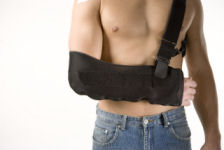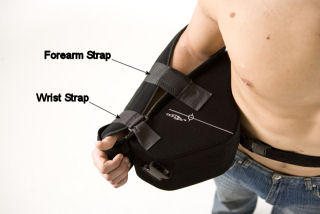Capsular Plication
One of the reasons shoulders become unstable and/or recurrently dislocate out of joint is because the capsule (lining of the joint) becomes excessively loose. This can happen in association with a Bankart lesion , or without one (as in Atraumatic Instability or 'loose shoulder'). In these circumstances an Arthroscopic Capsular Plication may be performed by the surgeon, with or without a Bankart repair (depending on the presence of a Bankart Lesion).
Capsular plication has a similar effect to thermal capsular shrinkage , but the effect lasts longer ( click here ).
How is it done?
The aim is to bring the capsule of the joint closer to the bones of the joint, making the joint tighter and reducing the joint volume and looseness (laxity). It also has the effect of improving joint proprioception (i.e. feedback to the muscles from the nerve endings in the joint).
- An angled suture passer (45 degrees) is inserted into the capsule and ...
- ... twisted, such that some capsule is captured.
- The suture passer is then moved closer to the glenoid and more capsule (and labrum) captured, thus 'shifting' the capsule - sometimes called a 'nip and tuck'.
- The suture (in the passer) is pushed through the passer and into the capsule, whilst the passer is reversed out.
- The suture is tied.
- This can be repeated until thecorrect amount of tightening is achieved.
Note how much closer the capsule is to the bone on image 6 compared to image 1.
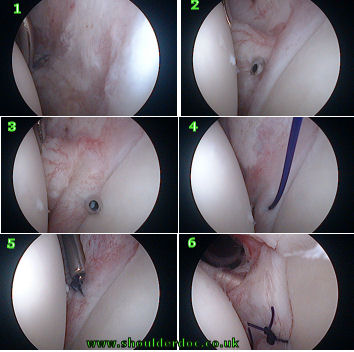
Below is an Animation of the procedure:
Below is a video of the procedure as seen at arthroscopy:
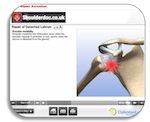 Click here for another Surgical Animation
Click here for another Surgical Animation
Your Operation
You must not eat or drink anything after midnight the day before your surgery. When you wake up following the procedure you will be wearing a sling with a body belt. This may be a standard sling or an External Rotation sling, depending on the procedure performed (see pictures below). The sling should be worn at night and when out and aboutfor 3 weeks. You will then wean off the sling with the aid of your physiotherapist over the next 3 weeks.
For more details on Living with a Shoulder Sling CLICK HERE
You should be able to go home the same day as your operation, but may be in hospital overnight. A physiotherapist will see you in hospital to teach you the appropriate exercises. You may also see an occupational therapist to give you advice regarding the use of your arm.
PAIN
A nerve block is usually used during the surgery. This means that immediately after the operation the shoulder and arm often feel completely numb. This may last for a few hours. After this the shoulder may well be sore and you will be given painkillers to help this whilst in hospital. These can be continued after you are discharged home. Ice packs may also help reduce pain. Wrap crushed ice or frozen peas in a damp, cold cloth and place on the shoulder for up to 15 minutes. Ensuring you cover the wound site with a piece of cling film to keep the area dry.
THE WOUND
This keyhole operation is usually done through two or three 5mm puncture wounds. There will be no stitches only small sticking plaster strips over the wounds. These should be kept dry until healed. This usually takes 5 to 7 days.
SLEEPING
For the first three weeks your sling must be worn in bed. Sleeping can be uncomfortable if you try and lie on the operated arm. We recommend that you lie on your back or on the opposite side, as you prefer. Ordinary pillows can be used to give you comfort and support. If you are lying on your side one pillow slightly folded under your neck gives enough support for most people. A pillow folded in half supports the arm in front and a pillow tucked along your back helps to prevent you rolling onto the operated shoulder during the night. If you are lying on your back, tie a pillow tightly in the middle (a "butterfly pillow") or use a folded pillow to support your neck. Place a folded pillow under the elbow of the operated arm to support that.
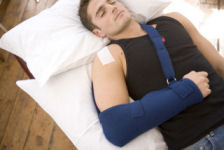
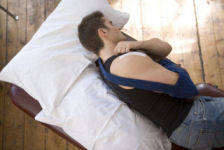
FOLLOW UP APPOINTMENTS
An appointment will be made for you to see the surgeon or specialist therapist 3 weeks post-operatively.
DAILY ACTIVITIES
For the first three weeks most activities of daily living for example feeding, dressing, cooking etc must be carried out using your un-operated arm. If appropriate an occupational therapist will be available to give you advice on how to do this.
LEISURE ACTIVITIES
Your physiotherapist and surgeon will advise you when it is safe to resume your leisure activities. This will vary according to your sport and level, as well as the period required to retrain your shoulder muscles with physiotherapy.
Below is a rough guide:
| Swimming | Breastroke Freestyle | 6 weeks 3 months |
| Golf | 3 months | |
| Contact Sport | Includes rugby, horse riding, football, martial arts, racquet sports, and rock climbing | 3 months |
DRIVING
You will not be able to drive for a minimum of 4 weeks. Your surgeon will confirm when you may begin.
RETURNING TO WORK
This will depend upon the size of your tear and your occupation. You will need to discuss this with your surgeon.
REHABILITATION PROTOCOL
The physiotherapy rehabilitation protocol will be a specialised Proprioceptive programme and vary according to the type of stabilisation performed. For more details Click Here


